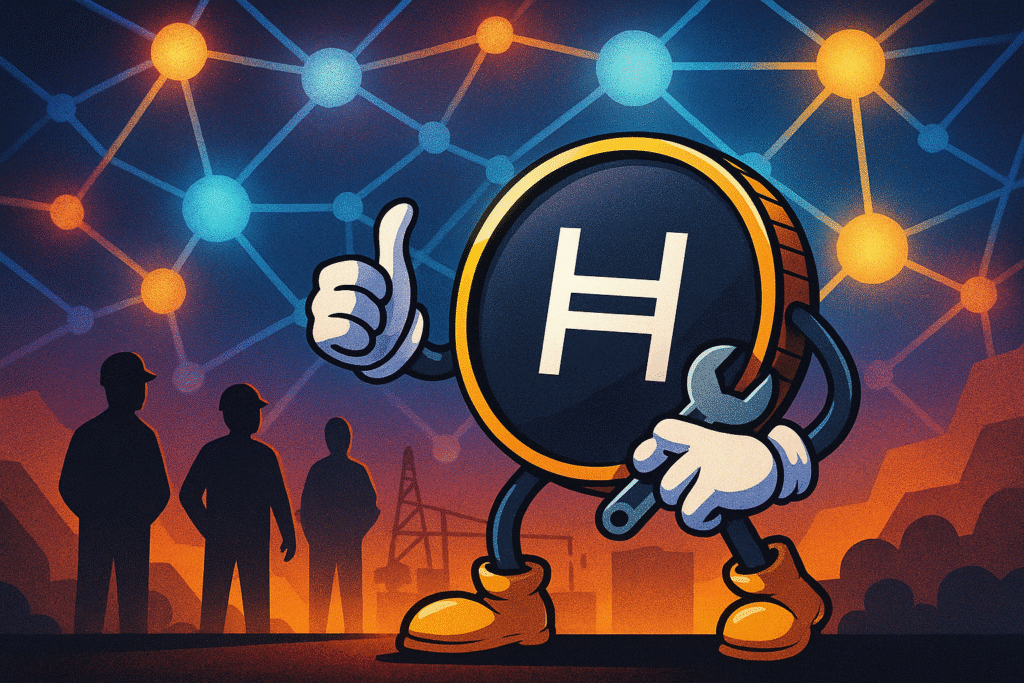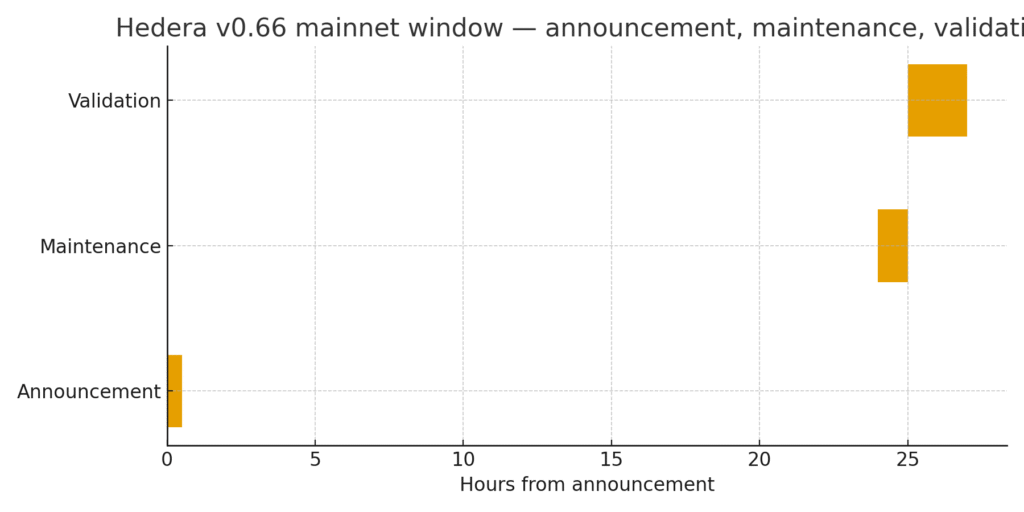
Hedera v066 enters mainnet with a short maintenance window and a clear set of platform improvements for the network and its services. The goal is simple. Improve predictability for smart contracts and tokens while reinforcing reliability for operators. This guide explains what Hedera v066 brings, how to prepare for the window, and how teams can validate compatibility before traffic resumes.
What is Hedera v066
Hedera v066 is a platform release for Hedera Hashgraph that updates node software and service components across consensus service, token service and smart contract support. The release focuses on stability and operator experience. It also includes performance tuning for contract execution and improved metrics for node operators.
How the v066 rollout works step by step
Announcement and status page. The council schedules the upgrade with a public status page. The page lists the start time in Coordinated Universal Time and the estimated duration.
Mainnet maintenance window. Nodes enter maintenance for a short period. During this window the network does not process normal transactions and mirror nodes may lag.
Node software update. Operators apply the v066 node software. Health checks and gossip resume once peers come back online.
Post upgrade validation. Operators verify consensus reach, check mirror lag, and observe TPS and latency. Clients can resume normal traffic once status returns to green.
Developer checks. Teams confirm that contracts and token flows behave as expected in staging and production. Logs are reviewed for warnings.
Key changes in Hedera v066
| Area | Change | Impact for builders |
|---|---|---|
| Smart contracts | Gas metering tuned for common precompiles and storage access | More predictable execution cost and fewer spikes during heavy periods |
| Token service | Better error surfaces for allowance flows | Easier integration debugging and clearer client logic |
| Consensus service | Latency smoothing for message submission and topic reads | More stable cross system messaging for app back ends |
| Node operations | Expanded Prometheus style metrics and alert signals | Faster detection of unhealthy peers and clearer dashboards |
| Mirror nodes | Catch up behavior improved during maintenance | Shorter lag after the window closes |

Figure 1. Hedera v066 release map that summarizes changes across contracts tokens consensus and node operations
Threat Model Snapshot
Scope. Short planned maintenance with software update on all mainnet nodes.
Assets at risk. Contract state integrity, token accounting, consensus finality, availability for wallets and back ends.
Attack surfaces. Node restarts, peer churn during rejoin, inconsistent SDK versions, stale mirror data, misconfigured alerts.
Mitigations in v066. Improved operator metrics that highlight slow peers, more explicit error codes for token flows, and guidance for client reconnection handling.
Residual risk. Brief service unavailability and temporary mirror lag. Apps that assume constant high throughput may see retries.
Defense Playbook in practice
Freeze writes during the window. Pause high value token mints burns and contract calls. Queue them for after status green.
Use automatic retries with backoff. On gRPC and SDK calls apply exponential backoff. Keep idempotency keys for critical workflows.
Monitor node and mirror health. Track TPS, average latency, and mirror catch up. Alert on abnormal deltas.
Validate contracts on testnet first. Run canary transactions that cover the top three paths of your app. Compare gas use with previous release.
Prepare a rollback path. Keep last known good container images and configuration. Document steps for a quick revert if your app shows anomalies.
PAA
Is Hedera v066 backward compatible for existing contracts
Yes. The release focuses on stability and metering. Normal contract logic should continue to work. Still run a smoke test before resuming full volume.
How long is the mainnet maintenance window
The window is short. The status page typically cites a period under one hour. Expect mirror nodes to need a bit longer to catch up.
Do I need to update my SDK or middleware
It is recommended to use the latest minor for your chosen SDK to ensure full compatibility with new error surfaces and metrics. Pin versions in production to avoid surprise changes.
Will tokens or account balances change after the upgrade
No. The upgrade does not alter token or account state. Only operational behavior and developer surfaces improve.
What to watch next
Operator telemetry. Watch for healthier propagation and fewer alert storms during traffic spikes.
Contract gas profiles. Track the top five high cost methods in your app. Confirm a smoother distribution after the update.
Exchange and wallet notes. Most partners publish a heads up around mainnet windows. Use those notes to schedule your own freezes and resumes.
Mirror node providers. Verify Service Level Objectives for catch up and retention. Adjust polling intervals if you read topics at high rate.

Figure 2. Maintenance timeline for Hedera v066 with start time duration and validation checks before traffic resumes
Sources and methodology
This article is based on public release notes and status communications from the Hedera project as well as developer documentation for services and SDKs. The focus is on operational readiness rather than price or trading. Primary sources are listed below as clean links.
Conclusion
Hedera v066 is a maintenance oriented release that sharpens the builder experience. Contracts see steadier gas behavior and token flows surface clearer errors. Operators gain better visibility and mirror nodes recover faster after maintenance. With a short window and a straightforward checklist teams can plan with confidence and return to normal throughput quickly.
Related Posts
External Sources
Hedera status page for mainnet maintenance
https://status.hedera.comHedera release notes v066
https://docs.hedera.com/hedera/status/mainnet/



3 Comments
Pingback: Tokenised stocks need real investor safeguards models gaps and the path forward (October 2025) - The Crypto Tides
Pingback: Visa rebrands DeFi as onchain finance and builds lending rails for banks - The Crypto Tides
Pingback: The Crypto Tides - WazirX restart and Recovery Tokens after the Singapore court approval